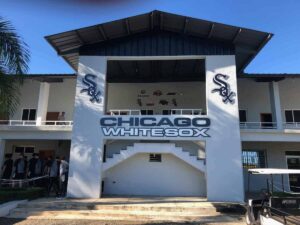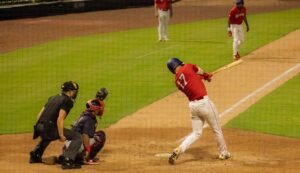Top White Sox Prospects – 2014 Preseason Top 25
Twice annually, in January and July, the writers at FutureSox work together to produce a list of the top prospects in the White Sox system. The list is released in two parts. We released the 11-25 list a few days ago, with capsule for each player, which you can see here. This is the full Top 25, including capsules for the Top 10.
NOTES ON ELIGIBILTY: We consider a “prospect” any player in the White Sox organization who has not yet achieved MLB Rookie status. This means players like Jose Abreu, Micker Adolfo and Adrian Nieto are eligible for the list, even though they’ve never seen the Sox minors (and in Abreu and Nieto’s cases, likely never will). Different media outlets may have slightly different rules or interpretations.
STATE OF THE SYSTEM: The Sox system is stronger than it’s been in years. Overall talent depth is greatly improved, and you no longer see national publications putting the Sox farm at the bottom of MLB (as it was for the past few years). Increased spending on the draft and international players, rebuilding of their Latin American operations, improved scouting, favorable changes to draft bonus rules and a swing of the prospect balance sheet from net negative (trading away) to net positive (acquiring) have all helped the system get to near major league average.
WHAT’S HAPPENED IN 6 MONTHS: Catcher Josh Phegley (#5 on the 2013 midseason list) and RHP Andre Rienzo (#15) have both “graduated”, having reached rookie status in MLB. LHP Santos Rodriguez (#25) was recently claimed off waivers by the Arizona Diamondbacks. Via trades late in 2013 and during the offseason, and even the Rule V Draft, the Sox acquired nearly a dozen eligible minor leaguers, while only losing one who had any shot at making the list (OF Brandon Jacobs, acquired then traded away in just a few months’ time).
THE LIST: Here are the Top 25 prospects in the White Sox system…
1. Jose Abreu, 1B [NEW]
- Signed from Cuba (via Haiti, DR) this offseason
The White Sox beat out numerous other teams to sign Cuban slugger Jose Dariel Abreu this offseason to a 6-year, $68M contract. The about-to-be 27 year old first baseman has torn up Cuban league pitching, as displayed in this video game-like stat line from his 2010-2011 Serie Nacional campaign: .453/.597/.986, 33 HR in 66 games. But what do those cartoonish numbers translate to in major league baseball? A formula developed by Baseball Prospectus writer Clay Davenport tries to apply some science to the translation, and was pretty accurate on Yasiel Puig. Abreu’s Davenport projection: .321/.446/.660, which is in the territory of Frank Thomas in his prime. That seems outlandish, but the picture it paints is that his ceiling could be very high. Abreu rates 70 to 80 on the power scale, and at 6’2″ and 250 pounds he’s a big man who is purely a 1B or DH. There is no speed there, and reports on his defense are mixed and sparse. Early reports from the Sox’ recent mini-camp for young players were very positive. Abreu is the White Sox 1B of the present and future and is unlikely to see the Sox minor league system. For an in-depth look at Abreu’s look at the plate, see this detailed Fangraphs GIF-based deconstruction.
2. Erik Johnson, RHP [Previous Rank: 1st, -1]
- Drafted 2nd Round in 2011
Johnson falls out the #1 slot due only to the presence of Abreu, and remains the best internally raised prospect in the White Sox system. Much as he did the previous year, the right-hander blew through minor leaguer hitters at two levels in 2013. In 14 games for Birmingham (AA) he posted a 2.23 ERA, 0.91 WHIP, .189 BAA, 2.2 BB/9 and 7.9 K/9 in 14 starts. Then promoted to Charlotte (AAA), he gave up even fewer runs and struck out yet more batters: 1.57 ERA, 1.08 WHIP, .209 BAA, 3.0 BB/9, 8.9 K/9. That earned Erik a promotion to the majors, a scant 2+ years after being drafted. In 5 starts for the White Sox, Johnson kept the earned runs down (3.25 ERA) and the walks under control (3.6 BB/9), but he gave up some hits (.281 BAA) and the strikeouts came down (5.9 K/9). This Cal product’s success rests with a low to mid 90’s four-seamer, two-seamer, a plus slider, above average change and a curveball. If you want a deeper look into his approach, read our interview with him here. Johnson is virtually assured a rotation spot in Chicago to open 2014.
3. Matt Davidson, 3B [NEW]
- Drafted 1st Round Supplemental (35th overall) in 2009
Acquired in December in exchange for closer Addison Reed, Davidson immediately jumps to near the top of the list. This third baseman’s plus power is obvious in the 20+ home runs in each of the past three seasons, and in 2012 he was named by Baseball America as the best power hitter in the Diamondbacks organization and best power prospect in the Southern League (AA). An ability to draw walks (and a knack for getting hit by pitches) has allowed him to compile a .351 OBP in the minors with a .268 average. Last season after putting up a .280/.350/.481 line at AAA Reno (in the notoriously hitter-friendly PCL), Davidson was promoted to MLB and put up a .237/.333/.434 line in 87 plate appearances, but he also struck out 24 times. Therein lies one of the two question marks with this prospect – will he make enough contact to use that power? After posting a reasonable K/PA rate in 2012 at AA (21.9%), the rate spiked to 26.8% in AAA last season and 27.6% in that short MLB stint. The other question with Davidson is about his defensive work at the hot corner, where scouts have noted improvement in footwork but still have concerns about the glove. Matt will be battling Conor Gillaspie for the starting 3B job in Chicago come spring, but could end up in AAA Charlotte (at least to start) for his age 23 season.
4. Marcus Semien, INF [Previous: 13, +9]
- Drafted 6th Round in 2011
No player in the Sox farm system had a bigger breakout season or ascended these rankings faster in the past year, than Marcus Semien. After a solid 2012 with Winston-Salem (A+) put him on the radar, his 2013 stop at Birmingham made him the Southern League MVP: .290/.420/.483, 84 BB vs 66 K, 20 stolen bases (5 CS) in 105 games. That performance got him promoted to Charlotte, where his numbers dropped off some (.264/.338/.464, 14 BB, 24 K), but he held his own, earning a final promotion to Chicago. In his first MLB stint (playing mostly 3B), his peripherals took a nose dive (1 BB, 22 K in 71 PA), though his core results suggest he wasn’t completely outmatched (.261/.268/.406). With the club sensing a potential 2014 player in the making, the 23 year old was sent to the AFL, where he struggled in 21 games(.156/.258/.273). While Semien’s plate discipline has been truly exceptional, his hit, power and speed tools are consistently rated out as average to above average but not elite. Defensively, he’s considered plus at 2B, somewhere around average at shortstop, and is learning 3B. Predicting this infielder’s 2014 is guesswork – a starting role, platoon/utility role, or more time in AAA are all reasonably possible at this point. But it would be surprising if he wasn’t on an opening day roster by 2015, if not earlier. Read our interview with Marcus here.
5. Tim Anderson, SS [Previous: 2, -3]
- Drafted 1st Round (17th overall) in 2013
Anderson’s drop from #2 to #5 is much less about his stock than it is the emergence of the players ahead of him, two of whom weren’t even in the organization at our last list. Given an aggressive assignment to Class A Kannapolis in his draft year (as the Sox are wont to do with high picks), the 20 year old put up a decent slash line (.277/.348/.363 in 301 PA), but also struck out a good bit (25.9%, though that decreased as the season went on). Coming out of a smaller JuCo program, his rawness is not surprising, and was somewhat exposed in skipping rookie ball. Anderson is very athletic and has plus-plus speed, while his bat shows a raw hit tool but hints at the potential for power. After focusing on basketball until reaching college, the key word with this speedy shortstop is “raw”, and he’s not likely to be a fast riser. Anderson will probably see Advanced A sometime in 2014, but may start the season back at Kannapolis before being promoted.
6. Courtney Hawkins, OF [Previous: 4, -2]
- Drafted 1st Round (13th overall) in 2012
As high-flying (literally and figuratively) as Hawkins’ draft year was, his 2013 was at best an uncontrolled descent to near ground level. The good news is, with the immense raw tools he has – plus raw power, plus arm, above average speed and athleticism – an ascent back to cruising altitude is still possible. This outfielder was clearly not ready for the aggressive assignment to A+ Winston-Salem as a 19-year old: he finished with .178/.249/.384 line and an alarming 37.5% strikeout rate. That K rate actually improved as the season went on – in his first 70 plate appearances the rate was an improbable 58.6%, and it was some 20% lower in the 2nd half than the first. His Iso SLG of .206 (and 19 HR) show that the power is still there, though as he struck out less often, the power also faded a bit. During those April struggles he had a lot of mechanical issues at the plate, but he made adjustments late in the season such as moving up in the batter’s box, losing the double-toe-tap and reducing some of his bat load noise. Reports on his defense were generally positive (a good sign that he didn’t take his struggles to the outfield), though he is still learning routes. Hawkins’ ceiling is still quite high, and he’ll likely repeat at Winston-Salem or even go back down to Kannapolis at age 20 to focus on pitch recognition and solidifying his mechanics.
7. Chris Beck, RHP [Previous: 9, +2]
- Drafted 2nd Round in 2012
Beck was considered a top 10 draft talent at one point with Georgia Southern, but a weaker 2012 season allowed the Sox to pick him up in the 2nd, and it appears they took a good gamble. Thanks to some conditioning program changes and some work from pitching coaches last fall, Beck put together a solid 2013 campaign across A+ and AA. In 21 games with Winston-Salem as a 22 year old, his core numbers and control were all OK to good (3.11 ERA, 1.34 WHIP, .265 BAA, 3.2 BB/9), and he induced plenty of ground balls (1.77 GO/AO), but his strikeout rate was surprisingly low (4.3 K/9). The strong right-hander may have been focused on using his sinking fastball to contact, because he was promoted to AA Birmingham and did well in 5 starts (2.89 ERA, 1.04 WHIP, .250 BAA, 1.0 BB/9, 7.1 K/9) as well as two strong post-season performances (11 IP, 9 H, 1 ER, 5 BB, 9 K). Chris has a heavy low to mid 90’s sinking fastball, cutter, slider and change-up. Likely this sinker-baller will start 2014 back in Birmingham, but he certainly could see Charlotte during the year.
8. Tyler Danish, RHP [Previous: 8, unchanged]
- Drafted 2nd Round in 2013
Tyler Danish’s performance as a high school senior was exceptional, even outside of a power conference: 94 innings, no earned runs, 156 strikeouts, and just 16 walks. The White Sox grabbed him in the 2nd round and people in the organization have said they considered him in the 1st as well, despite the fact that some scouting types see him as a future reliever. The reason for hesitation is primarly a high-effort, cross-body 3/4 slot delivery that has garnered comparisons to Jake Peavy, but which leads some to believe his body may not handle starting long-term. In his first pro season, the Sox kept him on a starting “schedule” but at reliever innings and the results were very encouraging: 1.20 ERA, 0.73 WHIP, .162 BAA, 1.5 BB/9, 8.4 K/9 in 30 IP across Bristol (Rk) and Kannapolis. That unusual delivery provides deception and gets him good sink on his 90-93 mph fastball as evidenced by his sky-high ground ball rate (3.36 GO/AO). In addition to the fastball he has a good slider and a work-in-progress change-up. The White Sox have made clear they see Danish as a starter, and he will likely be in Kannapolis’ rotation to start his age 19 season.
9. Micah Johnson, 2B [Previous: 12, +3]
- Drafted 9th Round in 2012
Few prospects in the Sox system have gotten as much attention for their performance in 2013 as Micah Johnson. He led all of minor league baseball in stolen bases (84), was 2nd in triples (15), and 5th in runs scored (106) despite missing a few games to a minor late season injury. He spent his first 77 games tearing up the South Atlantic League, posting a .342/.422/.530 line with Kannapolis. The speedster was then promoted to Winston-Salem where his numbers were less spectacular (.275/.309/.360 in 49 games), and got a late-season promotion to Birmingham for just 5 games plus their post-season. He capped off his year by making a brief 6-game appearance in the AFL (.320/.379/.520, 3 SB), before being shut down to have a nerve in his arm moved. This is his second time having that surgery (first was in college), but supposedly after this procedure he should be fully back to normal. A big question with Micah is his defense, where he struggled with the glove (29 errors) especially early in the season, and some have suggested an eventual move to the outfield. Probably too early for such a move, he’ll also need to show his dip in offense at High A was just an adjustment period. Johnson could start his age 23 season back at Winston-Salem, or given the White Sox’ track record with their favorite position player prospects, he may be pushed and start at Birmingham.
10. Trayce Thompson, OF [Previous: 3, -7]
- Drafted 2nd Round in 2009
The spectacularly athletic Thompson falls to his lowest ranking since being drafted after a disappointing 2013 campaign. After a breakout 2012 season and opening 2013 pretty well, his bat failed him in AA Birmingham and he finished with a .229/.321/.383 line, 23.6% K/PA and his lowest HR total (15) since 2010. Trying to get back on track, a VWL appearance in the offseason did nothing to ease concerns, as he hit .063 in 13 games before being released by Tiburones. Striking out too often has been a theme with Trayce, and the question has always been whether or not he’d make enough contact to make use of his impressive physical tools. On the encouraging side: that K rate is actually lower than it has been in previous seasons (28.8% in 2011, 28.2% in 2012), his defense remains legitimately plus in all facets, he still draws walks (60), and his speed is still a weapon (25 SB). Thompson has plus power, plus speed and is an elite defender in center field, and going into his age 23 season there is still both time and hope that he could approach his high ceiling. The prudent move would seem to be for him to repeat AA, but he could end up on AAA Charlotte’s roster.
11. Daniel Webb, RHP [Previous: 10, -1]
12. Carlos Sanchez, SS/2B [Previous: 6, -6]
13. Keon Barnum, 1B [Previous: 7, -6]
14. Jacob May, OF [Previous: 21, +7]
15. Jacob Petricka, RHP [Previous: 22, +7]
16. Scott Snodgress, LHP [Previous: 11, -5]
17. Micker Adolfo, OF [NEW]
18. Chris Bassitt, RHP [Previous: 29*, +11]
19. Trey Michalczewski, 3B [Previous: 14, -5]
20. Francellis Montas, RHP [NEW]
21. Rangel Ravelo, 1B [Previous: 24, +3]
22. Adam Engel, OF [NEW]
23. Myles Jaye, RHP [Previous: 23, Unchanged]
24. Jefferson Olacio, LHP [Previous: 30*, +6]
25. Eric Surkamp, LHP [NEW]
—
OTHERS RECEIVING CONSIDERATION: Braulio Ortiz, Adrian Nieto, Joey DeMichele, Keenyn Walker, Andy Wilkins, Kyle Hansen, Andrew Mitchell, Brad Goldberg, Jared Mitchell, Charlie Leesman
DROPPED FROM RANKINGS: Simon Castro (#17)
* = rank is implied, player was on “others receiving votes” list from previous version.
Let us know what you think! Anyone we over- or underrated? Comment on the article below, find us on Twitter (@FutureSox), or stop by SoxTalk.com for some discussion.





